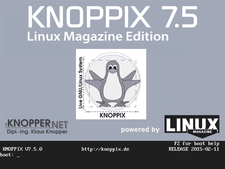Knoppix 7.5
Live Linux

Knoppix 7.5 is based on the current development version of Debian GNU/Linux and comes with hardware support from kernel 3.18 including many updates and new features.
The DVD in this month's issue is the exclusive Linux Magazine Edition of Knoppix 7.5, released in conjunction with the CeBIT 2015 Exhibition and Conference for IT and Digital Business in Hannover, Germany. This newest release from Klaus Knopper incorporates a number of new features, including kernel 3.18.6, Xorg 7.7 with core server 1.16.2 for hardware support, a custom SysVinit package for boot up, a small 12MB "boot only" CD ISO for those who cannot boot from a USB flash drive, a menu entry for the ClamAV scanner, the Knock kernel patch, an SSH server and client with TCP Stealth support, a number of new packages, and updates to standard software.
Debian systemd
Although you can find reasons for and against the use of systemd, the decision made by the Debian team to change the default boot system, along with tight integration by systemd of many system services, has greatly increased the complexity of system startup and made adjustments to the process difficult, especially when compared with the relatively primitive SysVinit.
The boot system in Knoppix, essentially comprising a single startup script for hardware detection and parallel launching of critical system components (knoppix-autoconfig) remains the same because it has its own SysVinit package. Systemd's own SysV replacement is not used in Knoppix, although the other systemd components are installed to resolve dependencies. This means that Knoppix boots up the same way it always has, unlike the Debian base since "jessie".
[...]
Buy this article as PDF
(incl. VAT)
Buy Linux Magazine
Subscribe to our Linux Newsletters
Find Linux and Open Source Jobs
Subscribe to our ADMIN Newsletters
Support Our Work
Linux Magazine content is made possible with support from readers like you. Please consider contributing when you’ve found an article to be beneficial.

News
-
Debian Unleashes Debian Libre Live
Debian Libre Live keeps your machine free of proprietary software.
-
Valve Announces Pending Release of Steam Machine
Shout it to the heavens: Steam Machine, powered by Linux, is set to arrive in 2026.
-
Happy Birthday, ADMIN Magazine!
ADMIN is celebrating its 15th anniversary with issue #90.
-
Another Linux Malware Discovered
Russian hackers use Hyper-V to hide malware within Linux virtual machines.
-
TUXEDO Computers Announces a New InfinityBook
TUXEDO Computers is at it again with a new InfinityBook that will meet your professional and gaming needs.
-
SUSE Dives into the Agentic AI Pool
SUSE becomes the first open source company to adopt agentic AI with SUSE Enterprise Linux 16.
-
Linux Now Runs Most Windows Games
The latest data shows that nearly 90 percent of Windows games can be played on Linux.
-
Fedora 43 Has Finally Landed
The Fedora Linux developers have announced their latest release, Fedora 43.
-
KDE Unleashes Plasma 6.5
The Plasma 6.5 desktop environment is now available with new features, improvements, and the usual bug fixes.
-
Xubuntu Site Possibly Hacked
It appears that the Xubuntu site was hacked and briefly served up a malicious ZIP file from its download page.

